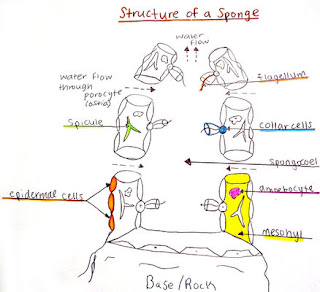Phylum Porifera : Sponges
Phylum Porifera
Sponges, stromatoporoids, and
archaeocyathids are included in this part because individual
members within each group share, at least partially, similar
skeletal features and symmetry leading some workers consider
them all as being members of the same phylum. All are
benthic, sessile, suspension-feeders which inhabited a wide
variety of exclusively marine environments throughout much
of the Phanerozoic.
CLASSIFICATION
& GEOLOGIC RANGES |
| Phylum
Porifera |
|
Class
Demospongea (Cambrian - Recent |
|
Class
Hexactinellida (Cambrian -
Recent) |
|
Class
Calcarea (Cambrian - Recent) |
|
"Class
Stromatoporoida" (Ordovician -
?Recent) |
|
|
|
Figure
2 - Basic Sponge
Morphology
|
|
|
|
|  |
|
|
|
|
From Boardman et al (1987)
|
|
|
The poriferans (sponges) are
characterized by cell groups that are independent of each
other and have the ability to change their function during
their life cycle. The skeletons of sponges can be composed
of an organic substance called spongin (the stuff of an
ordinary bath sponge), or they may have calcareous or
siliceous skeletons composed of chambers, or more commonly
rod-like branched elements called spicules. After death,
spicules are scattered across the sea floor and may be found
as disarticulated microfossils.  |
| Large spicules (visible to the
unaided eye) are termed megalascleres, whereas small ones
are called microscleres. Spicules have four basic
symmetries: (i) monaxon, (ii) triaxon, (iii) tetraxon, and
(iv) polyaxon. Examine Figure
2 below. Together the spicular
symmetry and mineral composition serve as the primary basis
in poriferan classification. |
Reproduksi
| Class
Demospongea |
Sponges with skeletons of spongin,
spongin and siliceous spicules, or a skeleton of fused
opaline silica. When present, spicules are commonly monaxon,
tetraxon, or polyaxon, but never triaxon. Here is an example
of a modern demosponge with spongin.  Here is a good example of a fossil demosponge.
Here is a good example of a fossil demosponge.
  Note in this specimen the canals in the siliceous
walls. Note in this specimen the canals in the siliceous
walls. |
| Class
Hexactinellida (previously
Hyalospongae) |
Sponges with siliceous spicules
that are usually triaxons and commonly fused to form a net
or box-like pattern. They are often called glass sponges.
For a recent example of a glass sponge, view this image. Compare it with Hydnoceras  from the Devonian of New York.
from the Devonian of New York. |
| Class
Calcarea |
|
Sponges that have calcareous
spicules as in Astaeospongia (the disc shaped fossil in the
following image) or more commonly, non-spicular porous
chambers (the other three fossils in the image). When
spicules are present, they are not fused and are typically
monaxons and/or tetraxons. |
| "Class
Stromatoporoida" |
| Although some texts treats this
group as a member of the demospongea, some paleontologists
consider stromatoporoids not as true sponges, but belonging
to their own phylum. The middle road is taken in this
course, treating the stromatoperoids as a separate class
within the Porifera. The sheet-like or hemispherical
skeletons of stromatoporoids are of two types. The first
type have small mounds called mamelons from which canals
called astorhizae radiate.
This group has horizontal partitions called laminae and
vertical partitions called pillars. The space between the
laminae and pillars is called the gallery. Compare the image
with the accompanying figure below. |
|
|
Figure
3 - Stromatoporoid
Morphology
|
|
|
|
|

|
|
|
|
|
From Boardman et al (1987)
|
|
|
The second type of stromatoporoid
is similar to the first in having laminae and possibly
pillars, yet it lacks the astorhizae and mamelons. This form
is quite similar to algal stromatolites, but differ in
possessing a true calcareous skeleton. Stromatoporoids such
as these  are quite common from the Silurian and Devonian
shallow-water carbonates of central New York and also the
Canadian Rockies where they often built reefs.
are quite common from the Silurian and Devonian
shallow-water carbonates of central New York and also the
Canadian Rockies where they often built reefs. |
Struktur
kalau ingin ngopy, wajib ucap Trima kasih....................!!!


 Note in this specimen the canals in the siliceous
walls.
Note in this specimen the canals in the siliceous
walls.






Tidak ada komentar:
Posting Komentar